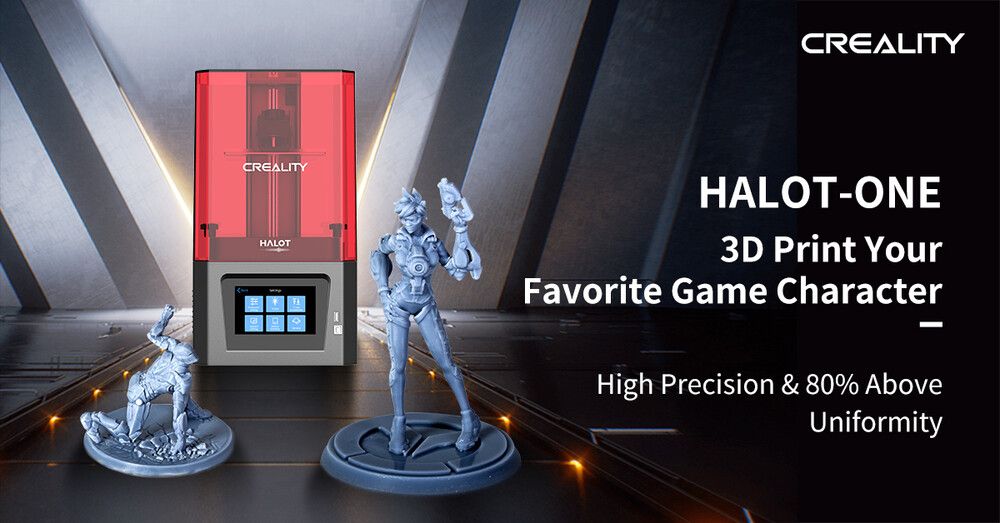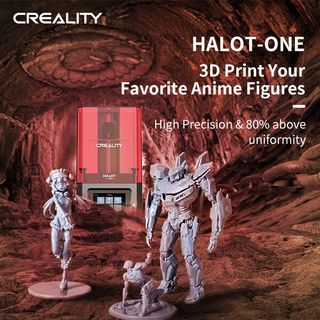Creality's HALOT 3D printers make resin printing easy

A Dungeons and Dragons dungeon master reveals that, instead of stand-in miniatures and vinyl battle mats, she'll be using custom models of everything her players will face in the coming sessions. A cosplayer creates his own props using 3D modeling software, and before long, he has exact replicas of his character's armor and equipment. A charitable soul manufactures medical equipment such as respirators and masks to donate to nearby hospitals.
These are just a few of the many things made possible by 3D printing. To say that the technology has been a game-changer for hobbyists would be putting it likely. It's been downright revolutionary.
And doubtless due in no small part to the pandemic, it's been experiencing something of a renaissance. Printers, at one time something that was only a feasible buy for the ultra-wealthy, have become more affordable. And the technology itself, previously confusing and frustrating to anyone who wasn't a dedicated hobbyist, has never been more accessible.

Creality's HALOT line of 3D printers is proof positive of that. Armed with an intuitive interface and proprietary slicing software, they're designed with novices and beginners in mind. That's a rare thing for resin printers, which usually feel like they're made for veteran hobbyists rather than newcomers.
Granted, that's at least partly by design — it's usually recommended that novices and beginners stick with filament printers until they're a bit more familiar with how 3D printing works.
Part of the reason is that resin is dangerous to work with if you don't know what you're doing. Both the fumes and the fluid itself prior to printing can be harmful without the proper PPE. The curing process can be a challenge too, as it generally involves 90% isopropyl alcohol and ultraviolet light.
There's also the fact that, if you don't properly calibrate a resin printer prior to using it, you're likely going to end up with some seriously janky prints. Filament carries none of these risks, and filament printers are usually simpler to use. Which is all well and good if you're doing larger, less precise prints.
But if you want something highly-detailed, such as a D&D miniature, most people will agree that resin is the way to go. Filament printers simply cannot provide the same level of detail. And truth be told, there's really something incredibly cool about watching a literal pool of liquid shape itself into something solid.

Which brings us back to Creality's HALOT series. Currently, there are three models available — ONE, SKY, and MAX. All three models use a powerful ARMCortex™ M4 processor, which provides both excellent data processing and efficient power consumption.
The HALOT-ONE also features a 5.96-inch monochrome LCD screen. Its intuitive interface is designed to simplify configuration and control, with clear visual effects and support for multiple languages. Better yet, thanks to over-the-air updates, you'll be able to enjoy a ton of new usability and quality of life improvements over your printer's lifespan.
Even cooler is the way they print. Most modern 3D printers use either Reflector or Parallax Matrix arrays to shape resin. Creality's HALOT printers, meanwhile, are equipped with their own proprietary Integral Light Source, giving them an edge in illumination, precision, and speed — you can see how the three stack up to one another in the table below.
| Row 0 - Cell 0 | Integral | Reflector | Parallax Matrix |
| Source | Multiple miniature light sources. Each source is composed of 4 light-emitting chips. | Four 405 nm ultraviolet lamp beads focused by a reflective cup. | 10+ matrix quartz beads with a parallel light angle of 2 degrees. |
| Intensity | Potential uniformity of 80% even at higher intensities. Individual lamp beads do not impact this. | If any of the four beads begins to fail, deformation and other problems become increasingly likely. | Any issue with any of the beads has the potential to impact print quality, uniformity, and accuracy. |
All HALOT printers are also designed with efficient cooling and filtration, an absolute must if you're working with resin. The best part, however, is the price.
The HALOT-ONE costs just $260. That's cheaper than the majority of resin printers currently on the market, without sacrificing performance or print quality. It's essentially the perfect entry point into the world of 3D printing.
For more information about HALOT-ONE and Creality’s other LCD 3D printers, you can follow or connect with them on Facebook (https://www.facebook.com/Halot3d). You can also visit their website if you’re looking to purchase one of their models for yourself.
Sign up to the 12DOVE Newsletter
Weekly digests, tales from the communities you love, and more
